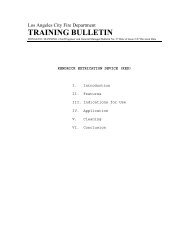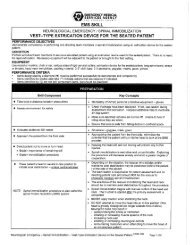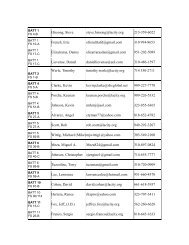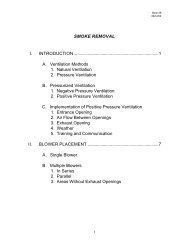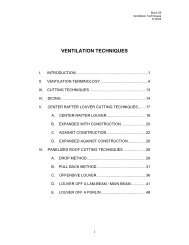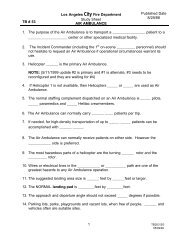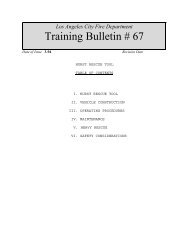TB 67 - HOLMATRO TOOLXX - A portal for all your training
TB 67 - HOLMATRO TOOLXX - A portal for all your training
TB 67 - HOLMATRO TOOLXX - A portal for all your training
You also want an ePaper? Increase the reach of your titles
YUMPU automatically turns print PDFs into web optimized ePapers that Google loves.
Los Angeles Fire Department<br />
TRAINING BULLETIN<br />
DOUGLAS L. BARRY, Fire Chief / Bulletin No. <strong>67</strong> / Date of Issue: 03/1994 / Revised 06/2008<br />
<strong>HOLMATRO</strong> RESCUE TOOL<br />
Table of Contents<br />
I. Holmatro Rescue Tool<br />
II. Maintenance<br />
III. Safety Considerations
Training Bulletin #<strong>67</strong><br />
June 2008<br />
Page 2<br />
INTRODUCTION<br />
The Holmatro Rescue Tool is a hydraulic<strong>all</strong>y powered device used primarily <strong>for</strong> vehicle<br />
extrications and can be used in heavy rescue applications. It is capable of developing<br />
thousands of pounds of pressure to spread, cut, pull or lift to effect a rescue operation.<br />
Presently, the Los Angeles Fire Department uses one brand of hydraulic rescue<br />
tool manufactured by Holmatro® Rescue Tools.<br />
I. <strong>HOLMATRO</strong> RESCUE TOOL<br />
The Holmatro Rescue Tool carried by Truck companies consists of:<br />
A. Power Unit - Two models with different specifications are depicted on<br />
Pages 3, 4 and 5<br />
Both units are powered by 4 cycle, air cooled Honda engines and use a<br />
positive displacement pump to draw and pressurize hydraulic fluid from<br />
the reservoir, direct the fluid through the hose and fin<strong>all</strong>y through the tool.<br />
Both power units utilize a two-stage pump design capable of producing<br />
10,500 psi. Initial extrication operations will only require use of the first<br />
stage pump, which is near 3,000 psi. When an operation requires<br />
stronger tool <strong>for</strong>ces, the second stage will “kick in” which can increase the<br />
hydraulic pressure up to 10,500 psi. This “change over” to the second<br />
stage can be recognized by a momentary “st<strong>all</strong>ing” of movement of the<br />
tool followed by a continued movement in the direction selected.<br />
Note: Members using the tools need to keep the trigger handle in the desired<br />
position during the “change over” phase to utilize the second stage of<br />
the pump. If the trigger handle is released at that time, the pump will<br />
go back to the first stage pressures and will take time to rebuild to<br />
activate the second stage.<br />
The fluid used in both pumps is a 22-weight mineral based hydraulic fluid<br />
that is pale or light yellow in color and is non-corrosive. Because the<br />
hydraulic fluid is the “life blood” of the system, special care sh<strong>all</strong> be given<br />
in assuring the proper level and cleanliness of the fluid is maintained.
Training Bulletin #<strong>67</strong><br />
June 2008<br />
Page 3<br />
Hydraulic<br />
Fluid Reservoir<br />
Fluid Sight Glass<br />
PPU 15<br />
• 35 lbs.<br />
• 2.5 horsepower Honda engine<br />
• 4500 rpm (set at factory)<br />
• 1.3 quarts regular unleaded gasoline<br />
• 2000 cc usable hydraulic fluid<br />
• Single tool operation<br />
DPU 30<br />
• 58 lbs.<br />
• 3 horsepower Honda engine<br />
• 3600 rpm (set at factory)<br />
• 1.5 quarts regular unleaded gasoline<br />
• 3000 cc usable hydraulic fluid<br />
• Dual pump <strong>for</strong> simultaneous tool use<br />
PPU15 Front View<br />
Photo #1<br />
Fuel Tank<br />
Fuel Sight Glass<br />
Female Coupling
Training Bulletin #<strong>67</strong><br />
June 2008<br />
Page 4<br />
Shut off button<br />
Fuel shut off<br />
Pull cord<br />
Photo #2 Photo #3<br />
PPU15 Rear View PPU15 Top View<br />
Photo #4<br />
DPU30 Front View<br />
Choke lever<br />
Fuel Tank<br />
Hydraulic Fluid<br />
Reservoir<br />
Female Coupling<br />
Dust Cap
Training Bulletin #<strong>67</strong><br />
June 2008<br />
Page 5<br />
Choke lever<br />
Fuel shut-off<br />
Pull Cord<br />
B. SPREADERS<br />
Photo #5<br />
DPU30 Rear view<br />
Shut off switch<br />
There is currently one spreader unit used on the truck companies. It is<br />
model 3260 UL. One member operates the spreader by use of the trigger<br />
handle.<br />
The trigger handle is of the “dead man” design which when rotated<br />
clockwise, causes the spreader to open. A rotation in the<br />
counterclockwise direction will cause the tool to close. When released<br />
from either position, spring tension will cause the trigger to return to the<br />
neutral position and movement of the tool will cease.<br />
A built-in check valve will keep the tool in its current position when the<br />
trigger handle is released while under load in either direction. Even when<br />
the pump is shut down or the spreader is disconnected from the hoses, a<br />
movement of the trigger handle in either direction will not cause the tool to<br />
release the load.<br />
There are two shackles provided <strong>for</strong> the spreader. They are equipped<br />
with a “grab hook” used to connect to the C-8 rated chain also provided.<br />
To inst<strong>all</strong> the shackles, first depress the spring-loaded buttons located<br />
towards the ends of the spreader arms and remove the tips. Next align<br />
the shackle on the end of the each spreader arm, depress the buttons and<br />
slide the shackle on until the buttons pop back out.
Training Bulletin #<strong>67</strong><br />
June 2008<br />
Page 6<br />
There are also two cutter tips included <strong>for</strong> panel cutting. Usu<strong>all</strong>y only one<br />
cutter tip is used, while one spreader tip is used as a base. The cutter tips<br />
are inst<strong>all</strong>ed the same way as the shackles. Uses <strong>for</strong> the cutter tips<br />
include panel vans, aircraft skins, semi-trailers or any other time when<br />
large panels of sheet metal need to be cut.<br />
3260 Spreader<br />
Chain Pulling Tips Spreading tip and Cutting Tip
Training Bulletin #<strong>67</strong><br />
June 2008<br />
Page 7<br />
C. CUTTERS<br />
All cutters also utilize the “dead man” trigger handle design. When the<br />
trigger is rotated in the clockwise direction, the cutter blades will open and<br />
when rotated counterclockwise, the blades will close.<br />
Note: Because of the powerful <strong>for</strong>ce employed while cutting with the Holmatro<br />
cutters, extreme care should be used to ensure that the tips of the cutters<br />
DO NOT cross over on the opposite side of the blades. Care should also<br />
be used to ensure that the material being cut does not cause the cutter to<br />
twist and <strong>all</strong>ow the blades to separate while cutting. Both scenarios can<br />
cause damage to the cutter blades as well as other components of the<br />
cutter unit.<br />
Three models of cutters are currently being used by the LAFD.<br />
3020 UL<br />
• 63,400 lbs. cutting <strong>for</strong>ce<br />
• 5 ¼” opening<br />
• 27 ½ lbs.<br />
3035 NCT (New Car Technology)<br />
• 57,320 lbs. cutting <strong>for</strong>ce<br />
• 5 5/8” opening<br />
• 33 ½ lbs.<br />
4050 NCT (New Car Technology)<br />
• 208,000 lbs. cutting <strong>for</strong>ce<br />
• 7 1/8” opening<br />
• 37 ½ lbs.<br />
3035NCT Cutter 4050NCT Cutter 3020 Cutter
Training Bulletin #<strong>67</strong><br />
June 2008<br />
Page 8<br />
D. TELESCOPIC RAMS<br />
Both utilize the same trigger handle mechanism as the previously<br />
mentioned tools. Rotating the handle in the clockwise direction will cause<br />
the ram to extend. Rotating the handle in the counterclockwise direction<br />
will retract the ram.<br />
Both rams are of the two-stage design whereas there is a plunger within a<br />
plunger that extends from the main body of the tool. The ram extends<br />
from the end nearest the handle.<br />
There is no provision <strong>for</strong> the use of the telescopic rams <strong>for</strong> a pulling<br />
operation.<br />
There are two models of telescopic rams currently carried by Truck<br />
companies.<br />
3340<br />
3350<br />
• 12” retracted to 23” fully extended<br />
• 49,210 lbs. <strong>for</strong>ce - 1 st stage, 18,210 lbs. <strong>for</strong>ce - 2 nd stage<br />
• 24 lbs<br />
• 21” retracted to 50 ¼” fully extended<br />
• 49,210 lbs. <strong>for</strong>ce - 1 st stage, 18,210 lbs. <strong>for</strong>ce - 2 nd stage<br />
• 37 lbs.<br />
3340 & 3350 Telescopic Rams Rams fully extended
Training Bulletin #<strong>67</strong><br />
June 2008<br />
Page 9<br />
HRS 22<br />
Each truck company also carries an HRS 22 Ram Support that can be used in<br />
conjunction with the telescopic rams.<br />
The main use <strong>for</strong> the ram support is two-fold. First, it provides a purchase point<br />
nearer to the object to be pushed when, <strong>for</strong> instance, a dashboard needs to be<br />
moved away from a patient. And secondly, it helps to spread the <strong>for</strong>ce load<br />
against an object, giving the ram end a wider and more stable purchase point.<br />
Although the design of the ram support is to use the smooth round cross braces,<br />
the hex shaped braces are equ<strong>all</strong>y as strong. See photos below<br />
HRS22 Ram Support HRS22 used in dash push<br />
32’ Hand lines Connecting hose to tool
Training Bulletin #<strong>67</strong><br />
June 2008<br />
Page 10<br />
E. HOSES<br />
The hoses supplied with the Holmatro rescue tool come in two colors,<br />
orange and blue and are 32’ in length. The design of this hose is unique<br />
to the fire service to where the inner, high pressure (supply) hose is<br />
encapsulated and protected by the outer, low pressure (return) hose.<br />
Both inner and outer hose are constructed of polyurethane and rein<strong>for</strong>ced<br />
with Kevlar-like Aramid fibers, which make them resistant to kinking. There<br />
are bend restrictors at each end of the hose, which provide protection<br />
where the fitting and the hose meet. The working pressure of the hose is<br />
10,500 psi with a burst pressure rating of 4 times that or 42,000 psi. See<br />
photo previous page.<br />
F. COUPLERS<br />
All Holmatro hydraulic hoses and rescue tools come standard with flat<br />
faced, no-drip, auto locking, quick couplers. These couplers have a built<br />
in automatic return valve that eliminates the need <strong>for</strong> a dump valve on the<br />
pump and <strong>all</strong>ows the “hot swapping” of tools. Each coupler, male and<br />
female, has a protective cap designed to keep out dirt as well as protect<br />
the coupler from damage when not in use. Special care should be taken<br />
to ensure that couplers as well as the caps are thoroughly cleaned be<strong>for</strong>e<br />
storage to keep dirt and other contaminants from entering the hydraulic<br />
system. See photo previous page.<br />
G. PRESSURE RELIEF DEVICE<br />
Each motor/pump unit comes with a pressure relief device that is to be<br />
used to relieve built up pressure in the hoses and tools. The device is<br />
used by placing the male end of the hose coupler in the open end of the<br />
device and turning the black knob clockwise until the plunger in the male<br />
coupler is depressed and a sm<strong>all</strong> amount of fluid is released. The hoses<br />
and tools can become pressurized when the tools are operated to their<br />
fully opened or closed position and then the trigger handle released. See<br />
photos next page.<br />
To avoid the inadvertent build-up of pressure in the tools and hoses, store<br />
the tools as follows:<br />
Spreader – Close until tips touch, then open one-quarter inch (1/4”)<br />
Cutters – Open or close blades until tips cross. If the cutter will not fit in<br />
the compartment this way, open completely, then close slightly.<br />
Rams – Fully retract piston, then open one quarter inch (1/4”)
Training Bulletin #<strong>67</strong><br />
June 2008<br />
Page 11<br />
Male coupler w/ dust cap Pressure Relief Device in use<br />
H. SECUNET<br />
The Secunet that is carried on truck companies and Heavy Rescue is an<br />
adjustable bonnet style, air bag restraint device that should be placed on a<br />
steering wheel with a non-deployed air bag prior to beginning extrication<br />
procedures. This device is the only one of its kind that offers protection to<br />
the vehicle’s occupant behind the steering wheel and rescuers while<br />
engaged in extrication operations. Employing the Secunet should be done<br />
without placing hands or arms in front of steering wheel in case of an<br />
accidental air big deployment, which could cause injury to the rescuer or<br />
vehicle occupant. The Secunet can be placed on a steering wheel over<br />
and over again to prevent expansion of the air bag, but if ever an air bag<br />
where to deploy into the Secunet, it sh<strong>all</strong> be taken out of service and a<br />
replacement ordered through the Shops. The manufacturer only<br />
guarantees a one-time deployment into the Secunet.
Training Bulletin #<strong>67</strong><br />
June 2008<br />
Page 12<br />
II. MAINTENANCE AND PERIODIC CHECKS<br />
A. Power Units<br />
Daily maintenance of the Holmatro power units consists of checking the<br />
fuel and hydraulic levels, on/off switch (DPU30) in the on position, choke<br />
in the proper position, fuel valve on, as well as a complete visual<br />
inspection of the power unit to ensure its readiness.<br />
On a weekly basis, the power unit should be removed from the<br />
compartment and engine oil and other fluids checked. Visu<strong>all</strong>y inspect<br />
that <strong>all</strong> fasteners are present and tight. The unit should be started and run<br />
<strong>for</strong> at least 15 minutes to ensure a smooth operation. While the power<br />
unit is running, connect a section of hose with a hand tool, operate the tool<br />
to its full open or closed position and continue to hold the trigger handle<br />
<strong>for</strong> a few seconds. Note the change in RPM be<strong>for</strong>e releasing the handle.<br />
This ensures that the second stage pump is operating and that the highpressure<br />
load will not st<strong>all</strong> the engine. Repeat this action in the opposite<br />
direction and then return the tool to its ready position.<br />
The monthly check should include inspecting the air filter <strong>for</strong> cleanliness,<br />
hose couplings <strong>for</strong> proper operation, dust caps and their tethers and the<br />
starter pull cord <strong>for</strong> fraying. Also check the condition of the fuel. (See<br />
section G)<br />
B. SPREADERS<br />
The daily check <strong>for</strong> the spreader unit is to ensure that the unit is ready <strong>for</strong><br />
use and the dust cap is in place.<br />
For the weekly check, a good over<strong>all</strong> visual inspection checking <strong>for</strong> loose<br />
and/or missing fasteners and that the trigger handle operates freely and<br />
returns to the neutral position when released. The tool should be<br />
connected to the pump, cycled at least one time and inspected <strong>for</strong> leaks<br />
and <strong>for</strong> any debris near the yoke area.<br />
Monthly, check <strong>for</strong> cracks or gouges in the arms and <strong>for</strong> any cracks or<br />
de<strong>for</strong>mities in the main body of the tool. Also, the operation of the spring<br />
loaded, quick pins <strong>for</strong> the tips should be checked by depressing the pins<br />
and removing the tip. Pins should move freely in both directions. The tips<br />
should be inspected <strong>for</strong> cracks and excessive wear and should be<br />
replaced if either of these two conditions exists.
Training Bulletin #<strong>67</strong><br />
June 2008<br />
Page 13<br />
C. CUTTERS<br />
As with the spreaders, the daily check on the cutters should be <strong>for</strong> its<br />
readiness and that the dust cap is in place.<br />
The weekly check is also similar to the spreaders in that a good visual<br />
inspection is needed to ensure that <strong>all</strong> fasteners are present and secure<br />
and the trigger handle operates correctly. The cutter should also be<br />
connected to the pump and cycled, paying particular attention inside the<br />
protective boot area <strong>for</strong> debris. Any <strong>for</strong>eign materials such as metal and<br />
glass that may have entered and become lodged in the yoke/pivot area<br />
may cause the cutters to operate improperly and potenti<strong>all</strong>y damage the<br />
tool. Most importantly, the hinge bolt nut needs to be checked <strong>for</strong><br />
tightness. This can be done by hand and if found to be loose, needs to be<br />
tightened to 75 foot pounds of torque.<br />
Also on a weekly basis, as well as after each use, the cutter blades sh<strong>all</strong><br />
be inspected <strong>for</strong> nicks, cracks and gouges. Because thousands of pounds<br />
<strong>for</strong>ce is exerted on the blades during cutting operations, <strong>all</strong> nicks and<br />
metal build up known, as “mushrooming” should be dressed with a file so<br />
that blades pass each other without any deflection. Any blade showing<br />
evidence of cracking sh<strong>all</strong> immediately be taken out of service and<br />
arrangements made to have the blade(s) replaced.<br />
As <strong>for</strong> the monthly checks, a visual inspection of the main body of the tool<br />
should be per<strong>for</strong>med to detect leaks and/or de<strong>for</strong>mities.<br />
D. TELESCOPIC RAMS<br />
The daily check is to include the ram’s readiness and that the dust cap is<br />
in place.<br />
Weekly, a visual inspection of the carrying handle and <strong>all</strong> of its<br />
components should be per<strong>for</strong>med as well as the ram ends <strong>for</strong> rotation.<br />
The ram ends should turn freely and swivel completely around. The<br />
trigger handle should also be operated to ensure proper operation.<br />
Monthly, extend the rams, fully checking <strong>for</strong> gouges or sharp points that<br />
may damage the end seals and cause leakage. Another area to inspect is<br />
the sm<strong>all</strong> chrome tube that runs along the main body of the ram. This is a<br />
return tube and if bent or punctured, will leak hydraulic fluid under<br />
pressure.
Training Bulletin #<strong>67</strong><br />
June 2008<br />
Page 14<br />
E. HOSES<br />
The daily check of the hoses consists of a visual inspection to ensure that<br />
the dust caps are in place and no fluid is leaking from the hoses.<br />
Weekly, when operating the hand tools, check the coupler <strong>for</strong> proper<br />
operation by connecting the hose to the hand tool. The coupler should<br />
make a full connection and a noticeable “click” with a slight rotation. If the<br />
coupler doesn’t make a full connection, apply WD40 or an equ<strong>all</strong>y suitable<br />
lubricant to the area behind the coupler and also to the face. Then, make<br />
and break the connection with a male fitting until the coupler makes a full<br />
connection. If after several attempts to make a complete coupling and<br />
coupler will not fully close, it may need to be replaced. Because these<br />
couplers are of a flat face, no-drip design, the tolerances are very tight and<br />
need to be kept free of <strong>all</strong> dirt and debris. The dust caps should always be<br />
wiped clean inside and out be<strong>for</strong>e placing them on a coupler.<br />
Because the hoses are the most abused component of the Holmatro<br />
rescue tool system, i.e. stepped on, drug across the ground, pulled across<br />
sharp objects, the full length of the hose needs to be inspected <strong>for</strong> any<br />
cracks, holes, abrasions that may cause leakage if not replaced. During<br />
the tool operation check, hold the trigger handle to the full open or closed<br />
position <strong>for</strong> about 5-10 seconds and check <strong>for</strong> leaks along the hose and<br />
the couplers. Any leaking hose should be taken out of service<br />
immediately and replaced by the shops.<br />
The hoses should be cleaned with a mild soap and warm water solution.<br />
If hoses become contaminated with grease, tar, battery acid or any other<br />
harmful product, a wiping cloth dampened with WD40 can be used to<br />
remove such products be<strong>for</strong>e cleaning with soap and water. To assure<br />
proper coupler operation after cleaning, apply WD40 to the couplers<br />
be<strong>for</strong>e placing back on apparatus.<br />
Addition<strong>all</strong>y, hoses should be stored in a coiled roll and not shoved into<br />
the handle of the spreader or cutter. Even though the hoses are<br />
constructed of Kevlar-like Aramide fibers and polyurethane and will not<br />
hold a permanent bend, prolonged storage in the tool handle can cause<br />
slight de<strong>for</strong>mities throughout the length of the hose. With the speed and<br />
ease of the single coupler design, there is no real advantage to keeping<br />
the tools pre-connected and stuffed into the handle.
Training Bulletin #<strong>67</strong><br />
June 2008<br />
Page 15<br />
F. ACCESSORIES<br />
On a monthly basis <strong>all</strong> accessories such as the HRS22 Ram Support,<br />
cutting tips, chain shackles and chains sh<strong>all</strong> be inspected <strong>for</strong> cracks, wear<br />
or any other damage that could possibly cause the part to fail during an<br />
operation. The Secunet® steering wheel airbag restraint should also be<br />
inspected <strong>for</strong> any possible contamination or tears in the fabric or straps<br />
and taken out of service if any of these conditions are found. Also, the<br />
Secunet® should be removed from service and replaced if ever there is a<br />
deployment into the restraint while on a steering wheel. The manufacturer<br />
will only guarantee a one-time deployment with this restraint.<br />
G. FUEL MAINTENANCE<br />
Because Holmatro uses Honda engines that are Cali<strong>for</strong>nia EPA approved,<br />
they have very sm<strong>all</strong> air ports and are susceptible to clogging and<br />
gumming with contaminated or “sour” gasoline. Current LAFD policy is to<br />
replace fuel in sm<strong>all</strong> motors every 30 days with fresh fuel. Also, a fuel<br />
stabilizer such as Sta-bil® or Seafoam® should be used to keep gasoline<br />
fresh. If unsure about <strong>your</strong> gasoline’s freshness, in an open, well<br />
ventilated area, dump a sm<strong>all</strong> amount of gasoline into a non-colored metal<br />
receptacle such as a coffee can and note the color of the gasoline. If the<br />
gasoline is beginning to turn yellow, dump the remaining fuel out of the<br />
power unit and dispose of properly. Replace with clean fresh fuel, which<br />
should be clear in color. Also, some of the power units have removable<br />
metal-screened fuel strainers in the neck of the fuel tank. This should be<br />
sufficient to strain the gasoline when refilling. If there is no strainer<br />
present, the use of a paint strainer will suffice.<br />
If at any time <strong>your</strong> Holmatro power unit runs rough or st<strong>all</strong>s when the<br />
choke lever is placed in the run position, contact the sm<strong>all</strong> engine repair<br />
mechanic at the Central shops and schedule maintenance <strong>for</strong> the unit.<br />
Running the power unit in the half choke position <strong>for</strong> extended periods of<br />
time can cause damage to the engine components.<br />
Because our Holmatro rescue tools are very crucial to the safe and timely<br />
extrication of persons trapped in vehicles, proper maintenance techniques<br />
sh<strong>all</strong> be adhered to, thus ensuring that the tools will per<strong>for</strong>m to their<br />
designed capacity.
Training Bulletin #<strong>67</strong><br />
June 2008<br />
Page 16<br />
III. SAFETY CONSIDERATIONS<br />
The hydraulic tools used in the fire service today are capable of producing<br />
thousands of pounds of hydraulic pressure within the tool system as well as<br />
being able to exert thousands of pounds of external <strong>for</strong>ce. These <strong>for</strong>ces, if not<br />
managed correctly, are capable of inflicting bodily injury to both the rescuers and<br />
the patients that are trapped in the vehicles in which we are working on. The<br />
following points should be considered when operating with and around these<br />
hydraulic rescue tools.<br />
• Be sure that <strong>all</strong> personnel using the tools are trained in the safe operation of<br />
such tools as per the manufacturer’s owner’s manuals and <strong>your</strong> company’s<br />
SOGs.<br />
• Proper maintenance of the tools will help to ensure their safe and efficient<br />
operation.<br />
• Always wear proper PPE’s such as helmet, goggles, gloves and protective<br />
clothing when operating the tools on an object.<br />
• Allow only the necessary personnel in the work area during an extrication<br />
operation and ensure that they are wearing proper PPE’s.<br />
• When operating tools in an environment where flammable or combustible<br />
liquids and gases are present, a loaded 1 ½” hose line and dry chemical<br />
should be in place and ready to protect personnel in the work area.<br />
• Always attempt to maintain good footing while operating the tools and avoid<br />
over-reaching that could cause a loss of balance.<br />
• Most hydraulic tools are designed <strong>for</strong> one-person operation. Both the<br />
operator and personnel nearby should be aware of the tool as it is operating.<br />
• Keep body parts away from the working end of the tool. The tools are<br />
extremely powerful and will not feel the resistance of flesh and bone.<br />
• Avoid situations that place you, the operator, in between the tool and the<br />
vehicle. If you end up in this position, stop the tool and place <strong>your</strong>self on the<br />
opposite or open side of the tool.<br />
• Be aware of a rotating tool to avoid the possibility of pinching <strong>your</strong> trigger<br />
hand between the tool and the object you are working on.
Training Bulletin #<strong>67</strong><br />
June 2008<br />
Page 17<br />
• Avoid cutting objects that are not intended <strong>for</strong> the tool.<br />
• When cutting an object blindly, such as a door hinge, pay close attention to<br />
the movement of the cutter. If the cutter twists or rotates excessively, stop<br />
and reposition cutter blades. Continuing to operate the tool when this<br />
condition exists could lead to blade damage or breakage, which could injure<br />
personnel.<br />
• When lifting vertic<strong>all</strong>y with a spreader or ram, be sure to use cribbing as you<br />
are lifting to avoid the possibility of and object f<strong>all</strong>ing and injuring personnel or<br />
patients.



